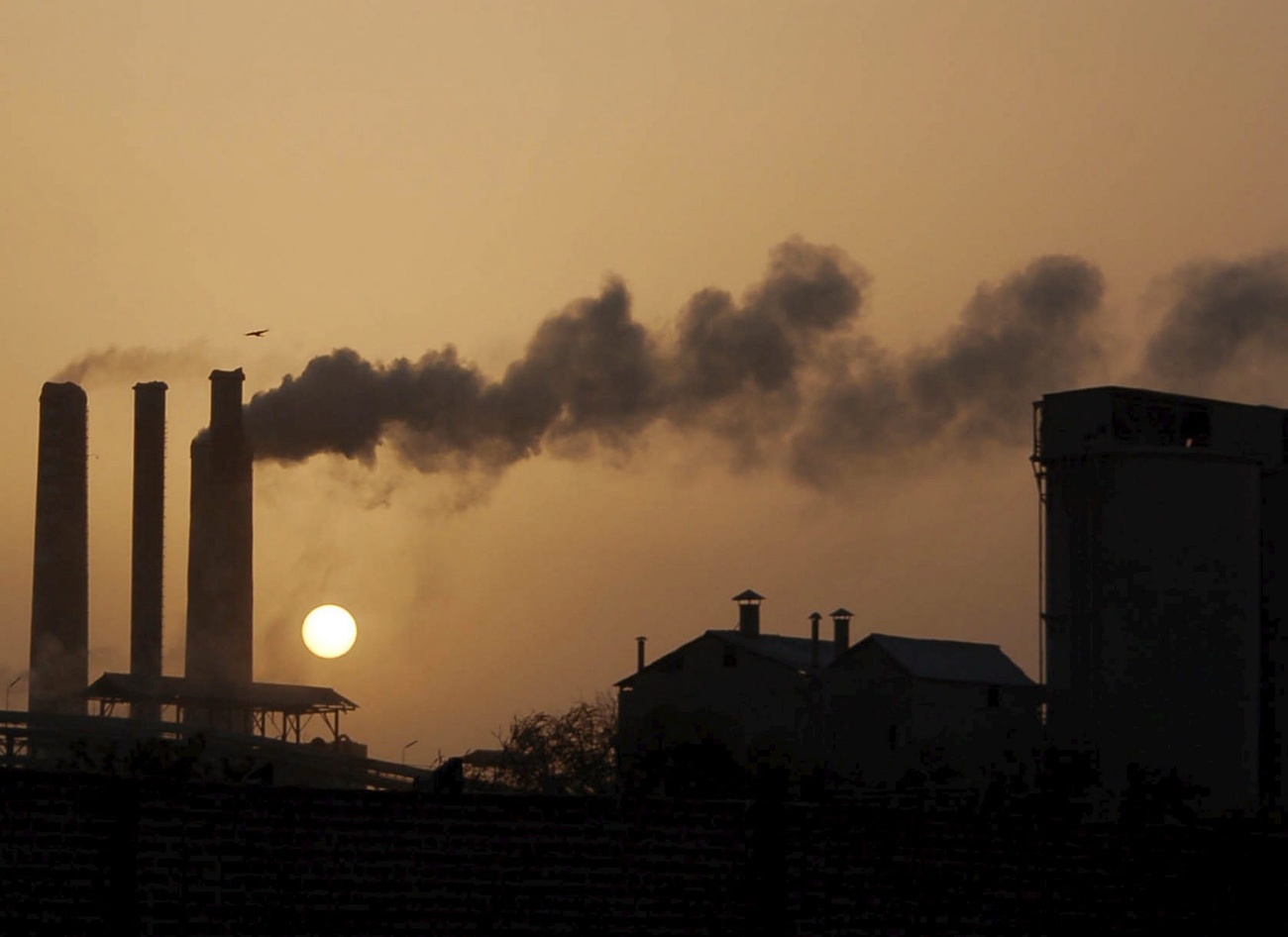Why a larger world population won’t necessarily mean more emissions

There are now more than eight billion people on Earth. Greenhouse gas emissions are also steadily rising. Yet some countries, such as Switzerland, show that the population – and even the economy – can grow without producing more CO2.
Out of the roughly 385,000 people who were born on November 15, 2022, one made history: he or she pushed the planet’s population to eight billion, according to estimates by the United Nations. The number of human beings on Earth has doubled in less than 50 years, a growth spurred by industrialisation and, more generally, by social and economic development. According to projections, the world’s population could top the ten billion-mark by around 2050.
At the same time, the amount of CO2 and other greenhouse gases emitted into the atmosphere has also risen and, like the world’s population, set a new record in External link2022. The two curves follow a similar trajectory, although since the start of the 20th century emissions have grown faster than the number of inhabitants.
However, there is no cause-and-effect relationship between population and emissions, according to demographics expert Clémentine Rossier, a professor at the University of Geneva Institute of Demography and Socioeconomics. “A population can be very big without necessarily having a harmful ecological footprint, and vice versa,” she says.
Multiple factors can contribute to rising emissions and, as the graphics below show, people’s lifestyles play a significant role in this. The case of Switzerland, however, indicates that it is possible to pollute less without giving up on comfort.
The Swiss emit more CO2 than the Chinese
The world’s countries have contributed unequally to the increase in CO2 concentration in the atmosphere. In 1960, the United States, Russia and Germany were responsible for over half of all greenhouse gases produced worldwide. Since the 1970s, China has been steadily climbing up the list of countries with the biggest climate footprint, and now occupies first place. While China burns the most coal for energy production, it is also the world’s largest exporter of goods. Many of its domestic emissions are therefore due to the manufacture of products used abroad.
China, the US and India are not only the world’s biggest CO2 emitters – they are also the most populous nations on the planet (for a combined total of three billion people). However, the equation is not so straightforward.
Not everyone on the planet has the same impact on the climate. A person living in China is responsible for an average of seven tonnes of CO2 emissions per year – about half as much as someone in Switzerland or the US. Put another way, and in purely numerical terms, a planet inhabited exclusively by eight billion Chinese would produce half as many emissions as an entirely Swiss or US population.
The volume of emissions is therefore not only linked to the number of people, but also to where they are and their standard of living. This begs consideration of an additional factor: wealth.
Wealthy people generate more emissions
In general, individual emissions are higher in countries with the highest per capita income. The reason for this is easy to see: gross domestic product (GDP) is directly linked to production, and in order to produce in economies that are heavily dependent on fossil fuels, such as oil and coal, a lot of emissions will inevitably be generated. Moreover, compared to poorer people, those with high incomes emit more CO2 through the purchase of goods and services, many of which are imported.
The richest 10% of the world’s population generates almost half of all emissions, while the poorest 50% are responsible for only about 12% of emissions, according to the World Inequality Lab’s 2022 reportExternal link, which contains the latest data on inequalities in the world.
“Internationally, there is a huge gap between the richest and the poorest,” says Julia Steinberger, a professor of ecological economics at the University of Lausanne. “In this context of inequality, the demographic growth of the poorest populations has no major impact on the climate. Action should rather be taken to reduce the emissions of the richest populations.”
According to the analysis and statistics site Our World in DataExternal link, if the population of low-income countries – which also have the highest fertility rates – increased by three to four billion people, global emissions would remain roughly the same. In contrast, one billion more people with high incomes and high living standards would increase emissions by almost a third.
Switzerland grows while emitting less
Even in this case, however, the correlation between emissions and wealth can be complex. Many countries – mainly industrialised ones such as Switzerland – show that it is possible to continue to grow without polluting moreExternal link. In economic parlance, this is known as “decoupling” – that is, disassociating population and GDP growth from increasing CO2 emissions.
Between 2000 and 2020, Switzerland’s population grew by 20%, to 8.7 million, mainly as a result of immigration. Per capita GDP increased by 25%, from CHF65,000 ($69,400) to around CHF80,400 per year. Over the same period, domestic and import-related (or grey) emissions fell by 13%, according to the Federal Statistical Office.
This means that today, a person living in Switzerland has, on average, a higher income than 20 years ago, but generates fewer emissions overall. The same can be said for those living, for instance, in the United States, Germany, France and Italy.
“Decoupling is boosted by the use of new technologies, such as renewable energies, electric vehicles and heat pumps,” says Lucas Bretschger, a professor at the Centre of Economic Research at the federal technology institute ETH Zurich. Around two-thirds of the electricity produced in Switzerland is generated by hydropower. Other solutions for reducing fossil-fuel dependence, such as better insulation of buildings, also help, Bretschger adds.
It would nonetheless be misguided to consider Switzerland and other industrialised countries that have decoupled as models to follow, according to Steinberger. Despite the drop in emissions, their climate footprint remains higher than that of most other countries in the world.
A few words about decoupling of CO2 emissions from GDP. Lots of people are sharing this plot as evidence that economic growth is universally compatible with emissions reductions. And let's be clear: emissions reductions here are real AND good news. However … pic.twitter.com/obLo2lRtfOExternal link
— @jks@kolektiva.social (@JKSteinberger) November 1, 2022External link
So what is the answer?
Limiting population growth to tackle the climate crisis, as advocated by a minority of demographers who took part in a 2020 international surveyExternal link, is not in itself a solution.
As stated above, the countries with the highest fertility rates, such as Nigeria and the Democratic Republic of Congo, also have the smallest impact on the climate. Instead, action should be taken in the richest nations, which generate the most emissions but have the most stable populations. In any case, the effects of any population policies would only be visible in 20 to 30 years – far too late against a backdrop of climate emergency.
For Rossier, the University of Geneva professor, there is only one possible option: “We must change our lifestyle to enable more people to live on Earth.” This does not mean “having to live in a hut”, she stresses, but rather adopting a more sober way of life – for example, living in smaller homes, consuming less water and energy, and giving up on some air travel.
Thanks to the technologies that exist today and further advances in the pipeline, everyone, Steinberger argues, should be able to live decently even on a planet with nine billion inhabitants – and in so doing, consume less than half as much energy as people do today.
Edited by Sabrina Weiss
Translated from Italian by Julia Bassam/gw

More
Swiss CO2 emissions: Small country, big footprint

In compliance with the JTI standards
More: SWI swissinfo.ch certified by the Journalism Trust Initiative












You can find an overview of ongoing debates with our journalists here . Please join us!
If you want to start a conversation about a topic raised in this article or want to report factual errors, email us at english@swissinfo.ch.